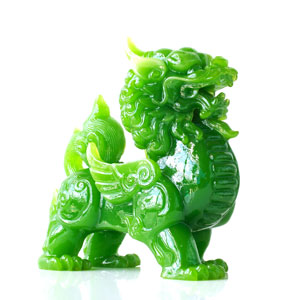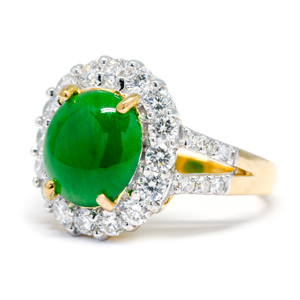jadeite
Jadeite, a captivating and highly-prized gemstone, draws its name from the Spanish phrase "piedra de ijada," meaning "stone for the pain in the side." This name hails from the belief that jadeite could cure ailments when held against the side. Composed of sodium and aluminium silicate, jadeite is one of two distinct mineral species known as "jade," with the other being nephrite.
Geologically, jadeite forms in high-pressure, low-temperature environments, often within subduction zones where tectonic plates collide. Notable sources include Myanmar, Guatemala, and Japan, with Burmese jadeite being particularly renowned for its exquisite quality and vibrant green colour.
What distinguishes jadeite is its stunning translucence, vivid green hues, and its highly sought-after imperial jadeite variety, known for its deep green shade. It has a rich cultural history, especially in East Asia, where it symbolizes purity, harmony, and longevity. Jadeite's exquisite beauty and cultural significance continue to make it a cherished gemstone worldwide.
Click on the terms in the table below to discover their meaning



Click on the terms in the table below to discover their meaning
| Name | Jadeite |
|---|---|
| Category |
Inosilicate |
| Chemical Formula |
Na |
| IMA Symbol | Jd |
| Crystal System | Monoclinic |
| Crystal Habit | Crystals rare, prismatic, showing cleavage faces; commonly massive or fibrous, granular, compact |
| Twinning | Single and lamellar twinning |
| Cleavage | Good |
| Fracture | Splintery |
| Tenacity | Tough; very tough when massive |
| Hardness (Moh's Scale) |
6 - 7 |
| Specific Gravity | 3.24 - 3.43 |
| Diaphaneity | Translucent |
| Colour | Apple-green, emerald-green, bluish green, leek-green, greenish white, white, yellow, orange, red, brown, grey, black, may show green spots, rarely blue or violet; colourless in thin section |
| Streak | White |
| Lustre | Subvitreous; pearly on cleavages |
| Optical Class | Biaxial (+) |
| Refractive index | nα = 1.640 - 1.681 |
| nβ = 1.645 - 1.684 | |
| nγ = 1.652 - 1.692 | |
| Birefringence | δ = 0.012 |
| Dispersion | Rd = 0.020 |
| Pleochroism | X = colourless or green; Y = colourless or yellowish-green |
| Clarity | Has own grading system (Type A, Type B, or Type C) |
| Notable Varieties | Imperial Jade, Kingfisher Jade, Apple Jade, Moss-in-snow Jade |
References
Geology Science. (2018). Jadeite. Retrieved from Geology Science: https://
Hudson Institute of Mineralogy. (2023). Jadeite. Retrieved from Mindat.org: https://
Mineralogical Society of America. (2001). Jadeite. In J. W. Anthony, R. A. Bideaux, K. W. Bladh, & M. C. Nichols (Eds.), Handbook of Mineralogy. Chantilly, VA 20151-1110, USA: Mineralogical Society of America. Retrieved from https://